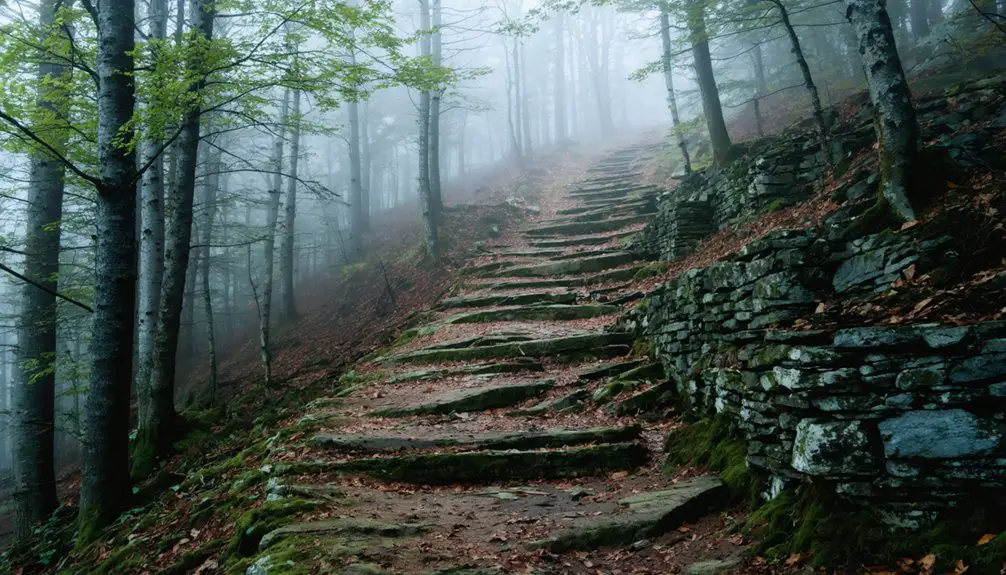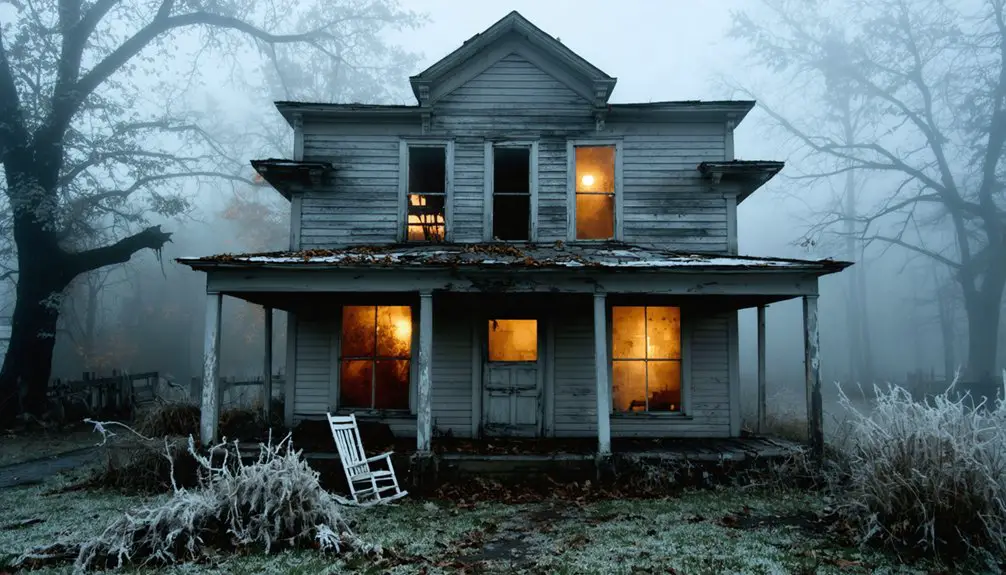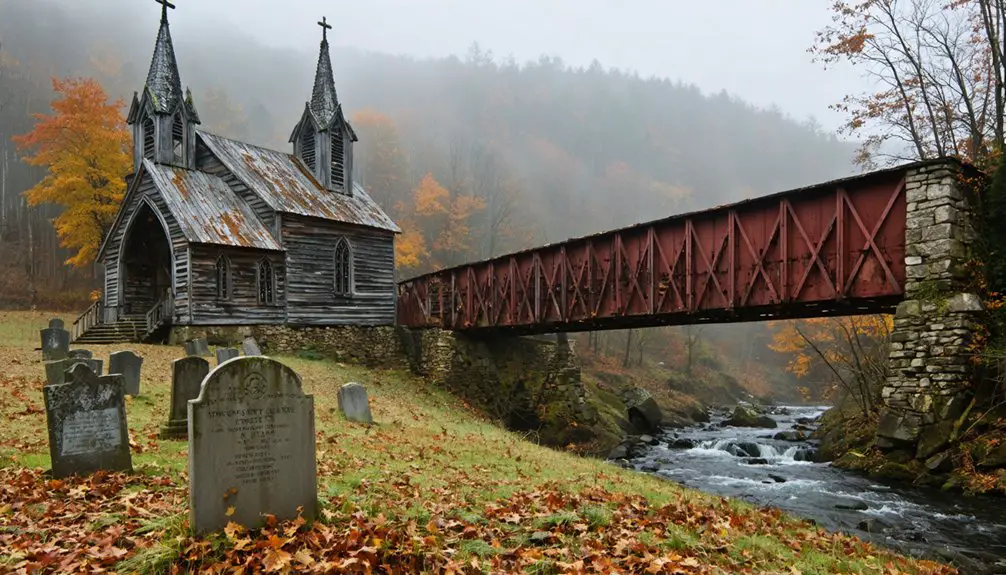You’ll discover Pumpkin Hill, a haunting ghost town deep in Vermont’s Bennington Triangle, where local folklore tells of unexplained phenomena and mysterious disappearances. This former 1850s logging settlement sits amid challenging terrain of 2,500-foot plateaus, marshy bogs, and thick forests. Today, you can explore the abandoned paths and historic remnants along a two-hour walking route, where cold spots and phantom sounds remind you of the site’s eerie past. The deeper you venture into Pumpkin Hill’s history, the more its mysteries unfold.
Key Takeaways
- Pumpkin Hill is a haunting Vermont ghost town known for unexplained phenomena, mysterious disappearances, and Native American legends.
- The abandoned settlement began as a logging community in the 1850s but was deserted by early 1900s after resource depletion.
- Located at 2,500 feet elevation, the site features brick kilns, historical structures, marshy wetlands, and ancient logging roads.
- Visitors report paranormal activity including ghostly encounters, unexplained cold spots, phantom footsteps, and mysterious vanishing trails.
- The site requires careful navigation via Main Street’s carriage road, with a two-hour hiking journey through challenging terrain.
The Legend Behind Pumpkin Hill
While Vermont’s landscape is dotted with abandoned settlements, none quite captures the imagination like Pumpkin Hill, where unexplained phenomena have woven themselves into the fabric of local folklore.
You’ll find yourself drawn into tales of legendary disappearances and ghostly encounters that have shaped this remote wilderness into a focal point of mystery.
What you might experience at Pumpkin Hill goes beyond ordinary ghost stories.
The Native American Abenaki tribe spoke of a man-eating stone in these haunted woods.
Visitors report strange sounds echoing through the forest – deep growls mixed with the rumbling of phantom boulders.
Similar to how metal detecting is strictly regulated at historic sites, paranormal investigations require special permissions.
You’ll hear accounts of people sensing shifts in time and space, as if crossing through an invisible barrier.
These experiences connect to the broader mysteries of Vermont’s Bennington Triangle, where the natural and supernatural seem to blur in ways that defy explanation.
Getting to Pumpkin Hill requires the kind of careful planning our ancestors once used when charting these remote Vermont mountains.
You’ll find the journey begins on Main Street’s carriage road, winding upward through terrain that tests both spirit and sole. Today, this path takes almost two hours to traverse by foot. The ghost town‘s network of old logging paths demands respect and preparation – you’ll need your GPS, compass, and physical maps to navigate the faded trail markers and mysterious splits. The path connects to the Slate History Trail, offering a glimpse into Vermont’s abandoned past.
Pack your sturdy boots and weather gear, as you’ll encounter everything from 2,500-foot plateaus to marshy bogs.
For trail navigation, watch for distinctive rock formations and abandoned structures that serve as vital landmarks. Remember, you’re following in the footsteps of hardy Vermont settlers – travel in groups, inform others of your plans, and carry emergency supplies.
The wilderness demands self-reliance, just as it did generations ago.
Natural Features and Terrain Challenges

As you venture into Pumpkin Hill’s remote wilderness, nature’s raw beauty masks genuine challenges that demand both reverence and caution.
You’ll need to navigate through thick forests and challenging natural terrain at elevations reaching 2,500 feet, where dense vegetation challenges even experienced hikers. Like the historic Monson Center site, the area has been largely reclaimed by nature after being abandoned.
Consider these essential terrain features you’ll encounter:
Pumpkin Hill’s varied landscape demands respect, as each terrain feature presents unique challenges that will test your outdoor skills.
- Ancient logging roads that snake upward through moss-covered forests before opening onto a mysterious plateau
- Marshy wetlands and natural ponds that require careful crossing on makeshift bridges
- Stream-crossed paths that weave through historical remnants, now reclaimed by persistent vegetation
The mountain’s raw character has preserved Pumpkin Hill’s secrets, as erosion and persistent plant growth steadily erase the last traces of human presence, returning the ghost town to its wild roots.
Historical Timeline and Settlement
You’ll find that Pumpkin Hill’s early settlement mirrored the familiar pattern of Vermont’s resource-based communities, with its first residents establishing themselves around local logging operations in the 1850s.
The community’s growth followed the typical boom cycle of Vermont ghost towns, as workers and their families built modest homes near the timber yards and charcoal kilns where they earned their living. The area contained approximately twelve brick kilns used for producing charcoal to support the local economy. Similar to Somerset, the town relied on the river transport to move lumber downstream to larger markets.
Just like neighboring Glastenbury, Pumpkin Hill couldn’t sustain its population once the surrounding forests were depleted, leading to its eventual abandonment by the early 1900s.
Early Mill Operations
The steady churning of water wheels marked the birth of Pumpkin Hill in the 19th century, when pioneering settlers established the town’s first mills along its rushing streams.
Like Egmont Key Lighthouse, the old water-powered structures stand as silent monuments to a bygone industrial era.
You’ll find that these early mill technologies transformed the untamed wilderness into a thriving hub of industry. Local families built intricate water infrastructure systems, including dams and mill races, to harness the power of Pumpkin Hill’s waterways.
The mill operations shaped the community’s very foundation through:
- Family-operated grain grinding and lumber processing that served both local and regional needs
- Year-round employment opportunities that attracted skilled workers and their families
- The creation of a vibrant trading center that supported blacksmiths, merchants, and transporters
These water-powered establishments became the heartbeat of Pumpkin Hill, where freedom-seeking settlers built their dreams of independence through honest labor and craftsmanship. Many mill workers and merchants regularly traveled to Burlington, Vermont to trade their goods and acquire supplies for the growing settlement.
Settlement Pattern and Decline
While the mill operations brought initial prosperity to Pumpkin Hill, the settlement’s story took a distinctly different path from other Vermont communities.
You would’ve found a rugged landscape where settlement challenges made farming nearly impossible, forcing residents to rely solely on logging and charcoal production. Unlike other Vermont towns that diversified with mining or resort development, Pumpkin Hill’s economic isolation left it vulnerable to decline.
Throughout the mid-1800s, you’d have encountered mostly transient workers living in rough conditions, with just basic amenities like one-room schoolhouses and company stores. Much like Ricker Basin, the town struggled against the harsh conditions that would eventually force its residents to leave.
As timber resources dwindled in the late 1800s, families began abandoning their homes. The harsh terrain and lack of alternative industries sealed the community’s fate, leading to complete abandonment by the early 20th century.
Unexplained Phenomena and Local Stories

As you walk through Pumpkin Hill’s abandoned paths after sunset, you’ll hear the unmistakable sounds of footsteps and whispers that locals have reported for generations.
You’ll notice the sudden, inexplicable cold spots that seem to follow you near the old ruins, even on the warmest summer evenings.
Perhaps most puzzling are the winding dirt trails that seem to vanish and reappear with each visit, leading some to believe the ghost town’s spirits are still guiding – or misdirecting – their visitors.
Strange Sounds After Dark
Deep within the forested slopes of Pumpkin Hill, visitors have reported mysterious nocturnal sounds that defy conventional explanation.
You’ll hear tales of unexplained noises that combine deep growls with what sounds like massive boulders rolling through the wilderness. These eerie experiences often leave witnesses shaken and disoriented, especially when the sounds emerge from the dense forest after dark.
If you’re exploring the area, you might encounter:
- Massive purr-like vibrations that make your hair stand on end
- Low-frequency rumbles emerging from off-trail locations, typically from the left
- Thunderous sounds near the ghost town’s remains that seem to distort time and space
Many locals believe these phenomena connect to the area’s haunted history, while others suggest natural causes like geological shifts or unknown animal activity.
Mysterious Cold Spots
The unsettling sounds of Pumpkin Hill aren’t the only phenomena that’ll make your skin crawl – the ghost town harbors another chilling mystery in its abandoned halls and weathered ruins.
You’ll encounter inexplicable cold spot phenomena throughout the site, where temperatures plunge 10-15 degrees below the surrounding air. These ethereal pockets of cold often coincide with locations of tragic historic events, drawing countless paranormal investigators who’ve documented these temperature fluctuations with thermal cameras and infrared equipment.
When you explore the old mill town’s remains, you might feel these sudden, localized chills – brief moments where the air turns icy despite sealed rooms and still conditions.
While some attribute these cold zones to underground streams or structural quirks, many locals believe they’re marking places where spirits of Pumpkin Hill’s past still linger.
Hidden Paths Disappear
While exploring the dense forests surrounding Pumpkin Hill, you’ll discover a peculiar phenomenon that’s puzzled our community for generations – logging trails and carriage roads that seem to vanish without explanation.
Our grandparents once traversed these paths daily during the bustling timber years, but nature has reclaimed many of these historic routes.
- Old-timers tell stories of disappearing trails that led to thriving logging camps, now swallowed by thick undergrowth and fallen trees.
- Flash floods and erosion have torn away bridges and railway lines, leaving ghostly gaps in our once-connected network of paths.
- Ancient stone cairns stand as silent witnesses along these fading routes, their true purpose lost to time.
These vanishing paths remind us of our community’s deep connection to these mysterious woods and the secrets they still hold.
Planning Your Ghost Town Adventure
Before starting your journey to Pumpkin Hill ghost town, careful preparation will guarantee both safety and enrichment during your exploration of this fascinating piece of Vermont history.
Your ghost town preparation should begin with securing detailed maps and GPS coordinates, as the old carriage road leading from Main Street can be tricky to navigate.
Pack exploration essentials including sturdy hiking boots, water, snacks, and emergency supplies – you’ll be venturing far from modern amenities.
Research the town’s early 1800s origins and understand why its residents left, just like nearby Ricker Basin and Glastenbury.
Bring a fully charged phone, but don’t count on service.
Most importantly, respect this heritage site by following Leave No Trace principles, preserving what remains for future adventurers to discover.
Present-Day Site Conservation Efforts
Thanks to dedicated preservation efforts, Pumpkin Hill’s ghostly remnants stand protected for future generations to explore and cherish.
Through thoughtful site stewardship and conservation practices, local historical societies and environmental groups work together to maintain this precious slice of Vermont’s past.
You’ll find these key preservation initiatives in action:
- Protection of historic structures and cellar holes through stabilization work that uses period-appropriate materials
- Creation of carefully designed walking trails that protect both archaeological sites and native wildlife habitats
- Installation of interpretive signage that tells the story of early settlers while guiding visitors to minimize their impact
Your respectful exploration of these carefully preserved ruins helps guarantee that Pumpkin Hill’s legacy continues to inspire future generations of history enthusiasts.
Frequently Asked Questions
Are There Any Remaining Artifacts From Original Settlers That Visitors Can See?
You’ll discover tangible settler artifacts through stone walls and cellar holes that’ve endured time, plus a historic cemetery where original headstones stand as powerful reminders of early community historical preservation efforts.
What Wildlife Species Are Commonly Encountered When Hiking to Pumpkin Hill?
You’ll spot moose, beavers, woodchucks, and gray squirrels along your hike. Practice trail safety, as these creatures need space. Bird watching reveals songbirds, raptors, and woodpeckers in their natural habitat.
Is Camping Allowed Near the Pumpkin Hill Ghost Town Site?
While you won’t find modern ghost town amenities nearby, you’re free to camp according to state regulations – just pitch your tent within three nights on state lands or 14 days in national forest.
What Caused the Final Residents to Abandon Pumpkin Hill?
You’d find that economic decline stripped away jobs and hope, while relentless natural disasters wore down the community’s spirit. The last families simply couldn’t sustain their way of life anymore.
Are Guided Tours or Local Historians Available for Site Visits?
You won’t find official guided tours, but nearby Burlington’s ghost walks offer similar experiences. Local historians might arrange private visits if you’re willing to reach out and explore independently.
References
- https://www.youtube.com/watch?v=ScW-H7A8yL8
- https://en.wikipedia.org/wiki/List_of_ghost_towns_in_Vermont
- https://nostoneunturnedadventures.com/2017/09/07/not-your-grandmas-pumpkin-patch/
- https://vermontcountry.com/wp-content/uploads/2021/08/UPCO-Sept-Oct21.pdf
- https://www.exploreasheville.com/article/how-spend-halloween-asheville
- http://freepages.rootsweb.com/~gtusa/history/usa/vt.htm
- https://www.instagram.com/reel/DBqvoTHO7Ck/
- https://www.nhmagazine.com/the-mystery-of-monson/
- https://extapps.dec.ny.gov/docs/lands_forests_pdf/lebhillsump.pdf
- https://obscurevermont.com/tag/ghost-town/



